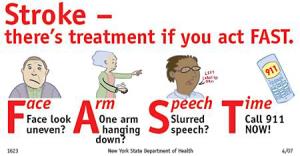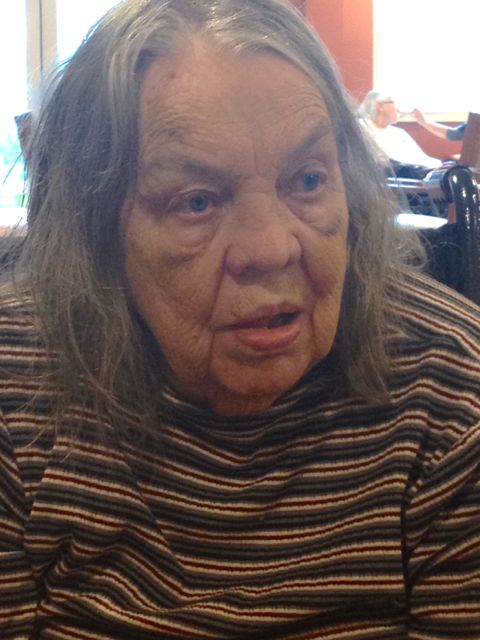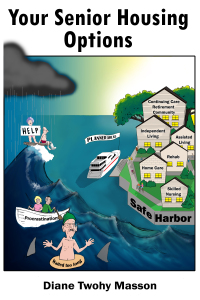
by Diane Masson | Apr 12, 2015

Diane’s Mom Driving -Illustration from the new resource guide “Your Senior Housing Options.”
What about you? Does one of your loved ones have dementia and still drive? Dementia drivers are jeopardizing other citizens walking in crosswalks and driving.
My father-in-law was driving with a diagnosis of macular degeneration. He justified his actions by only driving in the daytime and limiting himself to a 5-mile radius to run errands and go the doctor. As his dementia progressed he got lost driving home within this radius. He chose to give up driving on his own.
A friend told me about my mother driving several years ago. They said, “I saw your mom driving today, she can’t even see over the steering wheel. She is looking through the steering wheel in order to see the road.” I was horrified. This was completely unsafe. I still vividly remember the last time I drove with my mom. She was straddling two lanes (on the same side of the road). She said, “Diane, I know this looks bad, but I know exactly what I am doing.” I was terrified. It was the beginning of her dementia.
A resident of a senior living community drove into another resident’s balcony. As he was parking the car, the senior hit the gas instead of the brake. After backing up, he made the same mistake again and rammed the balcony a second time. Afterwards, he was disoriented and could not remember how the accident happened or why he hit the gas twice. He did not give up his car keys after this incident. The resident whose balcony was destroyed requested to have the parking place right outside his apartment home, because he did not want a repeat performance.
All these senior driving circumstances have made me a better defensive driver. Many people are concerned about teenage drivers, but what about seniors with dementia? No senior wants to give up the keys to the car and lose their independence. Senior housing choices that provide transportation can be a good choice for a senior who should not be driving.
Do you feel that a son or daughter should make a mom or dad give up the car keys if they are putting others at risk? What will be the trigger event to make the decision of no more driving – hitting a curb, a fender bender, or a fatal car accident?
What should the doctor’s role be in this process? Have you had the “car talk conversation” with yourself, your spouse, or your parent? How did it go? What about senior living providers who have residents that are driving unsafely in their parking lots? What did you do?
Seniors, Boomer children, spouses, family members and caregivers are desperate to learn how to truly differentiate good senior housing from mediocre at best. Diane Masson’s new book will answer these heart-wrenching issues in an easy, simple, story telling format with humorous illustrations. She has represented multiple styles of senior housing for 16 years and has sought all levels of senior housing care for her mother and stubborn German in-laws.
“Your Senior Housing Options” is a new resource book available on Amazon.com with a 5-star rating. It offers a step-by-step guide to the options, including staying home. Don’t wait until you’re in a health care crisis like author Diane Masson’s in-laws. Learn how to plan ahead like Masson’s mom. Research your future choices NOW to avoid being “put” somewhere, or having decisions made for you by others.
For weekly tips and advice go to www.Tips2Seniors.com and learn more from author and senior housing expert Diane Twohy Masson.

by Diane Masson | Apr 5, 2015
 Many seniors believe Medicare will take care of everything. It is an unfortunate perception that is inaccurate. Two days ago, I was presenting senior living options to a group of seniors. One senior raised their hand and asked how Medicare fit in the picture of paying for senior housing.
Many seniors believe Medicare will take care of everything. It is an unfortunate perception that is inaccurate. Two days ago, I was presenting senior living options to a group of seniors. One senior raised their hand and asked how Medicare fit in the picture of paying for senior housing.
Here was my answer, “You have worked hard your whole life to have Medicare insurance. Most seniors have Medicare, a HMO and supplemental insurance. These will help you pay for doctors, hospital stays and up to 100 days of skilled nursing care (if you have a qualifying hospital stay). Medicare will not pay for any long-term care such as support in an assisted living community, long-term skilled nursing care or memory care. (I know this was a short version of a long answer.)
Many seniors were surprised…here is some info from Medicare:
“At least 70 percent of people over 65 will need long-term care services and support at some point. ‘Medicare and most health insurance plans, including Medicare Supplement Insurance (Medigap) policies, don’t pay for this type of care, sometimes called ‘custodial care.’ Long-term care can be provided at home, in the community, in an assisted living facility, or in a nursing home. It’s important to start planning for long-term care now to maintain your independence and to make sure you get the care you may need, in the setting you want, in the future.” This is a quote from the official Medicare and You 2014 Handbook, page 63.
Have you encountered this misperception that Medicare will pay for long-term care?
Diane Twohy Masson’s new guide book for seniors, “Your Senior Housing Options,” is available on Amazon.com with a 5-star rating. It reveals a proactive approach to navigating the complex maze of senior housing options. It will help you understand the costs and consequences of planning ahead or waiting too long. Learn firsthand tips from someone who is currently advocating for three aging parents.
Among the thousands of seniors she and her teams have assisted in finding the right senior living community, the most difficult case has been helping her own parent. Masson spent two years exploring senior housing options with her mother before finding the ideal Continuing Care Retirement Community for her. After eight years in this independent living setting, she helped her mother transition into an assisted living community. Seven years later, even as a senior housing expert, Masson struggled with the decision to move her mother into a skilled nursing community.
More related articles by Diane can be found at Tips2Seniors.com or like Tips 2 Seniors on Facebook.
Diane Twohy Masson has worked in senior housing since 1999. She is an award-winning certified aging services professional and the author of Senior Housing Marketing: How to Increase Your Occupancy and Stay Full for senior living professionals.

by Diane Masson | Mar 29, 2015

Act FAST
My sister-in-law witnessed my father-in-law, Bill, having a mini-stroke (TIA) this week. What a heartbreaking story. She was sitting with him in the living room and noticed his face droop on one side. Then his speech became garbled. It was over in two minutes and he could talk fine again. He had no idea it happened.
She was understandable traumatized and wanted to talk about it. My husband and I are 1000 miles away and applaud her efforts to care for my father-in-law in her own home till he passes. We both think she is a saint.
Through my Internet research it says a TIA is a mini-stroke. TIA’s can be warnings that a bigger stroke can be coming. In my mom’s case, she has had so many TIA’s that she has been diagnosed with vascular dementia. I have never personally witnessed a TIA with my mom.
I guess you could say we were lucky it was only a TIA with Bill. Unfortunately, my father-in-law is now on hospice. Hospice is comfort care, so the goal is no hospitals or ambulances if at all possible.
Every caregiver, family member and senior living professional should know the signs of a stroke and what to do. Stokes can cause permanent damage. If you get someone to a hospital in time, it can reverse the affects of the stroke. Go to www.strokeassociation.org to learn more. They say you should act FAST! FAST stands for: face drooping, arm weakness, speech difficulty and time to call 911.
Have any of you encountered or witnessed a TIA or stroke?
Diane Twohy Masson’s new guide book for seniors, “Your Senior Housing Options,” is available on Amazon.com with a 5-star rating. It reveals a proactive approach to navigating the complex maze of senior housing options. It will help you understand the costs and consequences of planning ahead or waiting too long. Learn firsthand tips from someone who is currently advocating for three aging parents.
Among the thousands of seniors she and her teams have assisted in finding the right senior living community, the most difficult case has been helping her own parent. Masson spent two years exploring senior housing options with her mother before finding the ideal Continuing Care Retirement Community for her. After eight years in this independent living setting, she helped her mother transition into an assisted living community. Seven years later, even as a senior housing expert, Masson struggled with the decision to move her mother into a skilled nursing community.
More related articles by Diane can be found at Tips2Seniors.com or like Tips 2 Seniors on Facebook.
Diane Twohy Masson has worked in senior housing since 1999. She is an award-winning certified aging services professional and the author of Senior Housing Marketing: How to Increase Your Occupancy and Stay Full for senior living professionals.

by Diane Masson | Mar 22, 2015

Memory Care and Assisted Living Costs
Finding an affordable memory care or assisted living community can be a daunting task. Even this senior housing guru had to plan strategic questions before touring four memory care communities for my mother-in-law. See the questions HERE.
My husband and I flew 1000 miles to Seattle. We only had two days to tour memory care communities in the Seattle area. This required researching the Internet, calling former senior housing colleagues for recommendations and scheduling tours before we left. The timing was tricky because our limited time included visiting with my husband’s mom.
My husband created a spreadsheet to compare costs between these four memory care communities. The pricing is so complex that even someone working in the senior living field (like me) had trouble figuring out the monthly cost for my mother-in-law.
Care points, care levels or all inclusive costs?
Most assisted living and memory care communities seem to have a charge for room and board, then additional costs for care. Pricing can be very gray and feels like an illusion of smoke and mirrors. Care costs can be priced on a point system or a level system.
My mother-in-law, Amy, was assessed at 223 points at her current memory care community. Care costs varied dramaticly. Some of our tour guides were actually guessing what level of care or point total she might be, before a nurse could assess her. This is what makes pricing difficult to compare. The community recommends that you to move her in and then they will figure out the monthly price. Sigh…
Here were the room and board costs of four memory care communities in the Seattle area (these prices do not reflect care costs):
Community A Private Room: $2,330
Community B Private Room: $5,095
Community C Private Room: $4,050
Community D Private Room: $4,137
Room and board costs for a shared room in memory care are less:
Community A Shared Room: $1,050
Community B Shared Room: $4,895
Community C Shared Room: $2,850
Community D Shared Room: $3,837
So let’s try to figure out care costs:
Community A has four care levels: Amy’s current care level two (estimate) – $3,860
Community B has five care levels: Amy’s current care level three (estimate) – $2,595
Community C uses care points: Daily charge .54 a point x 223 = $3,613
Community D uses care points: Daily charge .73 a point x 223 = $4,884
So the price is so high, we decide to consider a shared room. So let’s add the shared room with the care costs to see what Amy would be charged each month:
Community A – Amy’s monthly total: $4,910
Community B – Amy’s monthly total: $7,490
Community C – Amy’s monthly total: $6,463
Community D – Amy’s monthly total: $8,721
Each place said it would reassess Amy in two weeks. They implied the price would bump down, but it might bump up in price. Right?!!? So that led us to ask what could be the maximum cost for Amy’s care in a shared room?
Community A – Amy’s maximum cost: $6,820
Community B – Amy’s maximum cost: $9,045
Community C – Amy’s maximum cost: $9,006
Community D – Amy’s maximum cost: $12,159
Community D was priced the highest, but it also had the highest staff ratio and was a drop-dead gorgeous new building. We had to eliminate it due to Amy’s finances. Community A was priced the lowest and had a wait list. It was cheaper, but gross and we saw a low staff ratio. So that left us Community B or C. Community B had a care level pricing and was brand new. Community C was based on care points and was a dated older community. This is where our spreadsheet came in handy.
The bottom line for the family: Amy’s care was more important than a new community that looked great walking in the lobby. We felt Community C had outstanding personnel! Every single person greeted us on our tour. They painted the picture of Amy’s reality, but explained how they would provide the best care in a homey environment. We felt they were experienced enough to correct Amy’s medications that had been over prescribed at the hospital (You can read about drugging and diapering seniors HERE.).
So Community C will initially cost the family around $6,000 a month, plus the one time community fee. They assessed Amy the same day we toured (another example of excellent service) and determined that 223 points was too high. Her new assessment is less than 200 points.
One-Time Community Fee
Assisted living and memory care communities typically have a community fee (one time) when someone moves in. Here were the memory care community fees for the four places we toured:
Community A: $2,500
Community B: $4,895
Community C: $6,500
Community D: $10,433
It’s complicated to compare senor-housing options; I hope this information can help you. Some other assisted living and memory care communities are all inclusive and only charge extra for incontinence care. Do your own research. Cheaper does not always mean better. Look beyond the superficial newness to the quality of the nursing and caregiver staff. Don’t forget to ask about turnover of staff. Community C has two key staff that have worked over 10 years for the company.
What have you encountered?
I haven’t even discussed who can afford these expensive prices? What about poverty level seniors? What happens when a senior runs out of money? Why is Medicaid almost impossible to find at licensed assisted living communities? These questions are addressed in my new book, “Your Senior Housing Options.” It is available on Amazon.com with a 5-star rating.

by Diane Masson | Mar 15, 2015

My sedated mother-in-law
Apparently drugging and diapering seniors in the hospital is common knowledge in higher levels of senior living care, such as assisted living, memory care and skilled nursing?!!?
This is horrifying new knowledge for me. I am all about exposing dirty secrets in my new book, “Your Senior Housing Options.” So let me share what I have recently learned through my mother-in-law’s experience. My mother-in-law, Amy, has dementia and was cared for by my father-in-law for the last several years. Three days after he had a heart attack, she became psychotic. My husband and I had to hire a geriatric care nurse to help her because we live 1000 miles away. Learn more of the story HERE.
It took over two weeks to get Amy admitted to the hospital (it’s a long story). Initially, we were relieved that she was going to get the psychotropic drugs she needed. Since Amy was in crisis mode, we didn’t dwell on her being diapered because of diarrhea. She’d had colon cancer 25 years ago and has self-managed her own colon care with diarrhea medications for years.
Costs for Incontinence
As she was in the process of transferring to a secured memory care, I was promised that they would be diligent about avoiding Amy’s trigger foods (that cause the diarrhea). My assumption was that she would surely regain continence again. This was vitally important, because incontinence can cost an additional $300 to $1,000 per month depending upon the assisted living community.
My Mother-in-law Was Over Sedated
We flew to Seattle to see Amy and to help find a reasonably priced memory care community for her. She was so sedated that she could not keep her eyes open and kept saying, “I am so tired,” over 25 times. She apologized that she needed to lie down and take a nap. She was in a wheelchair and needed a one person transfer to get in bed. What?!!? One month ago, she was walking around. My husband and I were shell-shocked to see her so drugged and lethargic. We talked to the memory care community and they said they would contact the doctor immediately to reduce the medications.
The next day, we arrived to see Amy again. After being told that she was engaged and walking around, we found her asleep in a wheelchair in the middle of a singing class. It was heart wrenching to witness. Again, she spoke of her sleepiness.
Advocacy is Key for a Senior with Dementia
The administrator came over and had the nerve to tell me, “My team feels we should follow the doctor’s recommendation of not changing Amy’s drugs for one or two months.” What?!!? I asked the nurse, “Do you see Amy’s lip trembling?” She said, “Yes.” I inquired if she saw both of Amy’s arms shaking too. She agreed. Then I said, “Do you see how sleepy she is and how her eyes can’t stay open?” “Yes,” she said. I simply said, “That is not Amy.” “Oh,” she said, “Then she is on too much medication.” “Exactly,” I said and was relieved that someone finally understood.
It took till the next evening for the community to contact her doctor and reduce one of her medications by half.
At this point Amy has been drugged and diapered for five weeks (between the hospital and the memory care community).
Conclusion:
That was five weeks too much of over drugging and diapering a senior with dementia. Can she ever come back and resume continence again? Will she be able to walk freely like she used to in her own home? My own mother was given psychotropic medications in skilled nursing care. Four months later, her walking had decreased dramatically; a few months later she became wheelchair bound for life. Was it the drugs or aging decline? I will never know, but I want to protect my mother-in-law from being over sedated and permanently wheelchair bound. I hope she has a fighting chance to walk again.
Drugs as Restraints?
I have talked with several administrators of assisted living and skilled nursing communities. They say it is common for seniors to arrive from the hospital drugged and diapered. The hospital can’t use restraints, so they use drugs as restraints. My mother-in-law was prescribed haloperidol twice a day and trazodone four times a day as needed. Why did the hospital dope her up so much? It is an advocacy nightmare to get it reversed.
What have you encountered? Has you ever witnessed the sedation and diapering nightmare of a senior?
Diane Twohy Masson’s new guide book for seniors, “Your Senior Housing Options,” is available on Amazon.com with a 5-star rating. It reveals a proactive approach to navigating the complex maze of senior housing options. It will help you understand the costs and consequences of planning ahead or waiting too long.
More related articles by Diane can be found at Tips2Seniors.com or like Tips 2 Seniors on Facebook.
Diane Twohy Masson has worked in senior housing since 1999. She is an award-winning certified aging services professional and the author of Senior Housing Marketing: How to Increase Your Occupancy and Stay Full for senior living professionals.
Among the thousands of seniors she and her teams have assisted in finding the right senior living community, the most difficult case has been helping her own parent. Masson spent two years exploring senior housing options with her mother before finding the ideal Continuing Care Retirement Community for her. After eight years in this independent living setting, she helped her mother transition into an assisted living community. Seven years later, even as a senior housing expert, Masson struggled with the decision to move her mother into a skilled nursing community.

by Diane Masson | Mar 8, 2015

“Your Senior Housing Options” Available Now!
“Your Senior Housing Options” is available now on Amazon.com.
As we age, it’s never easy to face the prospect of what to do when we need living assistance. But the reality is that two-thirds of today’s seniors will eventually need long-term care, with 20 percent needing it for longer than five years. If you are a retirement-age baby boomer or senior, don’t wait for a health crisis to occur. You owe it to yourself—and your family—to plan for the future today.
Although we’ve all heard horror stories, great facilities where residents are treated like gold are out there. How do you find them? You have to do your homework, ask the right questions, and look beyond the superficial to find what’s right for you.
With experience as both an industry expert and a loving daughter, Diane Twohy Masson is passionate about helping seniors find the retirement community that fits their price range, lifestyle, and needs. This brand new guidebook offers a proactive approach to navigating the complex maze of senior housing options. It will help you understand the costs and consequences of the various possibilities including home care, independent living, assisted living, group homes, memory care, and skilled nursing care facilities.
Order a copy of this valuable new resource by clicking HERE.
A valuable source of information by someone who works in the trenches. Whether you or a loved one are currently facing challenges, or if you simply want to be prepared for what you may face in the future, this provides the necessary tools. Knowledge is power.
Steve Fairfax, Currently helping my neighbor who has dementia
Diane answers questions most of us have not even thought of but desperately need to know. You will find valuable insight into the later years of life.
Dr. Jim Gwinn, Former President, CRISTA Ministries
As accountants, we can crunch the numbers. But Diane has outlined many issues we would never know, but which clearly need to be considered. This is an important resource in understanding key senior living issues.
Craig Huish, CPA, Waterfront CPA Group
Diane Twohy Masson has worked in senior housing since 1999. She is an award-winning certified aging services professional and the author of Senior Housing Marketing: How to Increase Your Occupancy and Stay Full for senior living professionals.
Among the thousands of seniors she and her teams have assisted in finding the right senior living community, the most difficult case has been helping her own parent. Masson spent two years exploring senior housing options with her mother before finding the ideal Continuing Care Retirement Community for her. After eight years in this independent living setting, she helped her mother transition into assisted living community. Seven years later, even as a senior housing expert, Masson struggled with the decision to move her mother into a skilled nursing community.
For more information, visit: www.tips2eniors.com or follow Tips 2 Seniors on Facebook.






